The spectacular rise and fall of the ‘Communist Concorde’
By Chris Leadbeater
Had you been peering up at the heavens just over 25 years ago, somewhere out in the fields on the vague periphery of the Moscow conurbation, you may have seen a ghost.
Not a ghost in the supernatural sense, obviously. This phantom would have been wholly tangible at ground level, all metal and wiring and paint. But it was also built of things you couldn’t have touched – flailing over-ambition, wild impatience and bitter military rivalry.
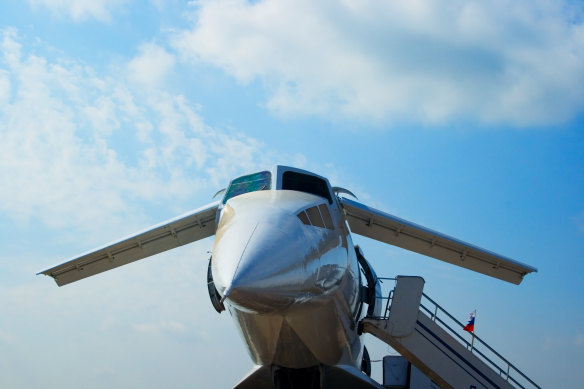
The Tupolev Tu-144 was a Soviet supersonic aircraft, similar to Concorde.Credit: iStock
This is why it was a ghost – a fragment of aviation history that would be fully and finally redundant the second it touched down that summer’s day.
June 26, 1999, was the end – the last flight of the Tupolev Tu-144. “Concordski”. The “Communist Concorde”.
In truth, the Soviet incarnation of supersonic air travel was already on the metaphorical scrapheap, having been mothballed two decades earlier.
And yet at one point, it had been the great hope of aeronautical engineering beyond the Iron Curtain; a grand feat that was going to be faster and more remarkable than anything the enemy could accomplish.
What might have been a considerable triumph resulted in failure and mortification, which makes for a story worth retelling – one of self-inflicted problems and soaring achievement brought low.
It is as much a tale of Cold War politics, politburo posturing and all-round hubris as it is an account of the race to break Mach 1.
A pyrrhic victory
In the grinding post-war struggle between East and West, there were always unspoken battles to be won. Supersonic aviation was just one such arena of tacit “conflict”.
Much like the atomic bomb and the space rocket, flight faster than the speed of sound was a holy grail, sought by big brains on both sides of the global divide. Where Britain and France conjured Concorde, Russia and its friends forged the Tupolev Tu-144.
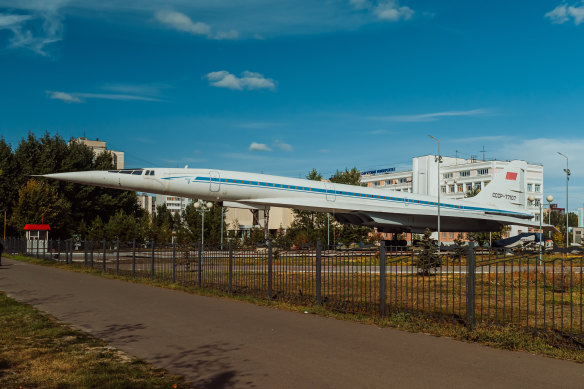
The surviving aircraft are now museum exhibits. This one is at the Kazan Aviation Institute in Russia.Credit: iStock
In this particular sprint, the Soviet Union was the winner – initially, at least. Similar in shape – all long pointed nose-cone and graceful broad wingspan – the Tupolev beat Concorde into the air by more than two months, taking off for its first test flight on December 31, 1968 (Concorde followed on March 2, 1969).
It could also fly quicker than its Anglo-Gallic competitor, reputedly able to zip along at a maximum 2657km/h (Mach 2.15) – where its western rival could “only” hit 2520km/h (Mach 2.04).
It was a pyrrhic victory. The aircraft was named after its designer, Alexsy Tupolev, a Russian aeronautics mastermind. He was a gifted man, also responsible for the “Soviet space shuttle”, the Buran. But his most famous plane soon became a byword for poor reliability.
An unnecessary deadline didn’t help. The departure of the first Tu-144 passenger flight was an exercise in pomp and circumstance, serenaded beforehand by a series of verbose speeches.
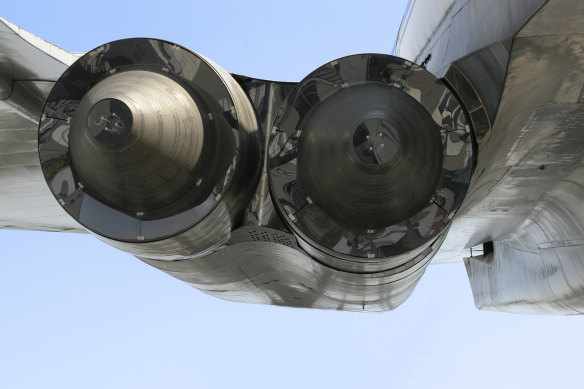
The Tu-144 could fly faster than the Concorde, at Mach 2.15.Credit: iStock
The date, November 1, 1977, was not chosen at random. It was meant, as near as possible, to coincide with the 60th anniversary (November 7, 1917) of the Communist Revolution which had pulled the Tsar from his throne and pushed Russia (and the planet) into a new era. Here was this reinvigorated superpower, just six decades on from its Year Zero, leading the world in shaping the most advanced transport technology.
The fact that Concorde was now properly airborne – its first commercial departures had taken off from London and Paris on January 21, 1976 – was an inconvenient truth not worth mentioning.
Whether the Tu-144 was ready to carry people at this stage was another matter. The flight, a two-hour dash from Moscow to the then-capital of Kazakhstan Alma-Ata (now Almaty), took place without incident. But signs of a rush-job were everywhere – wonky ceiling panels, broken reading lights, and toilets that did not work. It was an inauspicious start.
Things were scarcely better on subsequent services. Insufficient cabin pressurisation made the experience exceedingly uncomfortable for those on board; engine noise within the aircraft could be excruciatingly loud.
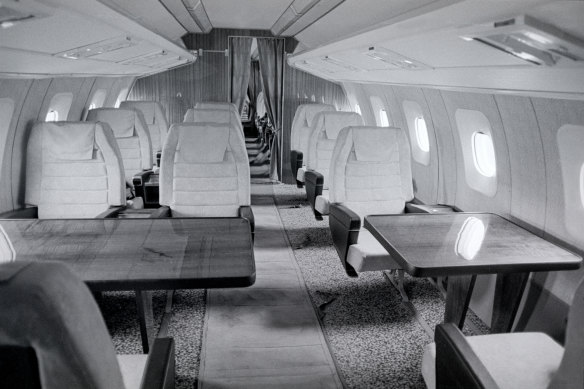
Despite a spacious first-class cabin, the ride was exceedingly uncomfortable due to extreme engine noise and insufficient cabin pressure.Credit: Getty Images
One departure, on January 25, 1978, proved especially troubled, as a plane crammed with foreign television and newspaper journalists suffered a series of system failures – the most concerning of which was an alarm that began to sound immediately after take-off.
Unable to silence it, the crew had to resort to stuffing pillows into the speakers. Amid the din, rumours spread that the Tu-144’s front and left landing gear could not be extended, that a crash was all but unavoidable – to the point that Soviet leader Leonid Brezhnev was kept informed of the plane’s fragile progress. As it transpired, it landed safely, but the raw stench of embarrassment lingered.
French fiasco
Only 16 Tu-144s were made. They only ever operated on that one route, to Kazakhstan. Even in the less safety-conscious environment of the Soviet Union, the plane’s wheezy performance made expansion into a wider network impossible.
By the early months of 1978, Tupolev himself was required to be on hand at Moscow’s Domodedovo Airport before every flight – there to sign off on the departing aircraft’s mechanical worthiness.
The worry was understandable. The Tu-144’s career was book-ended by disaster. Concorde, notoriously, suffered an accident which, along with financial factors, propelled it into retirement.
But, having beaten it into the air, the Tu-144 was also the first to crash.
On June 3, 1973, a development model plummeted to earth when a demonstration flight at the Paris Air Show went badly wrong – the plane twisting into an irretrievable nosedive.
The wall of silence was immediate, but two explanatory theories were proposed. One was that the Tupolev crew had been distracted by a French aircraft, sent up to photograph their display, and had lost control while taking averting action.
A second was that, in following a Concorde which had flown earlier, the Soviet pilots were indulging in a game of one-upmanship, and had attempted manoeuvres of which their Tu-144 was incapable.
Whatever the cause, the accident took 14 lives – all six of those on board, as well as a further eight unfortunate bystanders, killed as the consequent inferno devoured 15 homes.
Had this been an isolated fiasco, the plane might have lumbered on. But on May 23, 1978, another Tu-144 screamed down to terra firma during a test flight. When a fire broke out in the right wing, sparked by a fuel-line rupture, the aircraft belly-flopped. Two engineers died.
This was too much, even in the Soviet Union – where life was cheap but losing face was unforgivable. The last ever passenger service took off just eight days later, on June 1. And that was that. The operational history of the Soviet supersonic superstar amounted to seven months and 102 flights – of which only 55 carried passengers.
However, in formal terms, the death was slow. The Soviet decree which cancelled the Tupolev program did not arrive until July 1, 1983. In the intervening half-decade, basic engineering plodded on. The final Tu-144 in production – 77116 – was unfinished when the instruction to down tools finally came.
Its incomplete fuselage lay rusting on the airfield at Pridacha Airport – alongside the Voronezh Aircraft Plant, in western Russia – for years.
At the root of the dysfunction was a lack of research. Concorde underwent 5000 hours of tests before being certified for passenger service; the Tu-144 was subjected to half as much scrutiny (about 2500 hours) before receiving its rubber stamp.
Its initial test-flight took place on so odd a day – amid the winter weather of New Year’s Eve 1968 – because it had been written into the 1963 government decree that launched the program that the first flight would happen in five years. Simply, the Tu-144 took off at the last minute, irrespective of its state of development. In the hard context of the Soviet Union, it had to.
A last hurrah?
There were, of course, attempts to revive the corpse. The 1978 grounding of the Tu-144 fleet could not have come at a more awkward juncture for the Kremlin, two years ahead of a Moscow Olympics for which the politburo had envisaged Tupolev flights across European airspace.
Behind the scenes, through gritted teeth and back-channels, quiet requests were made to Concorde technical teams for assistance with parts and knowledge. The pleas were firmly rebuffed at ministerial level, including by Downing Street, amid fears that such expertise would find a path into Soviet fighter jets.
And yet, in the surging tides of Cold War antagonism, no idea was ever entirely dead. As the United States pushed new boundaries with its Space Shuttle missions in the early 1980s, Moscow strove to keep pace.
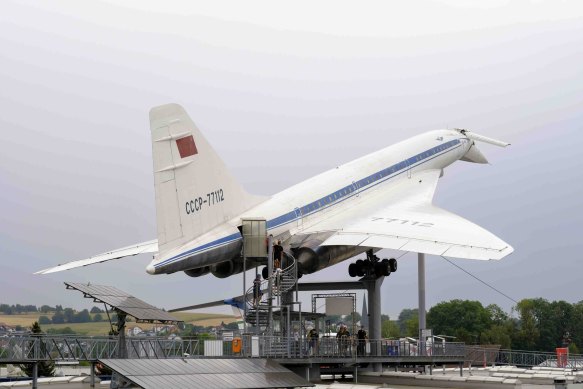
A Tu-144 at Technik Museum Sinsheim in Germany, the only version of the aircraft you can find outside Russia.Credit: Getty Images
And its eye alighted, once more, on the Tupolevs mouldering in hangars. Between 1985 and 1988, two Tu-144s were press-ganged into high altitude – redeployed as training craft and “flying laboratories” for cosmonauts hoping to go into orbit on the Buran. They never would. The “Soviet shuttle” completed a single, unmanned, spaceflight, in 1988 – before the curtain fell on the Soviet era in 1991.
Even then, there was an unexpected footnote – one which sounds as utterly implausible now, in the summer of 2024, with Moscow waging war in Ukraine, as it would have done to the various protagonists of the Cuban missile crisis in 1962.
For a short period in the 1990s, as relations thawed, East and West came together to talk about the final frontier.
They did more than talk. With the Berlin Wall – as well as the Soviet Union – gone, and Boris Yeltsin in the Kremlin, there was a brief window where the US and Russia collaborated on aerospace matters.
Nasa was taking cautious steps towards a second generation of supersonic passenger aircraft, sketching out a blueprint for what was known, clunkily, as HSCT (high speed civil transport).
To make progress, it needed existing gadgetry. And so a deal was struck. In 1995, Tu-144 77114 was dragged out of storage, given a $US350 million ($519 million) overhaul and sent back into the sky.
It made 27 test flights in 1996 and 1997 before a lack of further funding brought the project to an end in 1999. Images of the time show the aircraft with a highly unusual design on its colossal tailfin – the Stars and Stripes and the Russian Tricolour displayed together.
Fast-forward to today and sightings of the Tu-144 are just as rare. The surviving aircraft are museum exhibits, and only one can be found outside Russia – 77112, which was acquired by the Technik Museum Sinsheim (near Stuttgart, in south-western Germany) at the turn of the millennium.
As of 2001, it has been stationed on the museum’s roof, positioned next to an Air France Concorde. This is the only location in the world where the two supersonic passenger planes can be glimpsed side by side – Cold War rivals of yore, now brothers in arms, their visual similarities clear.
The Telegraph, London
Sign up for the Traveller newsletter
The latest travel news, tips and inspiration delivered to your inbox. Sign up now.